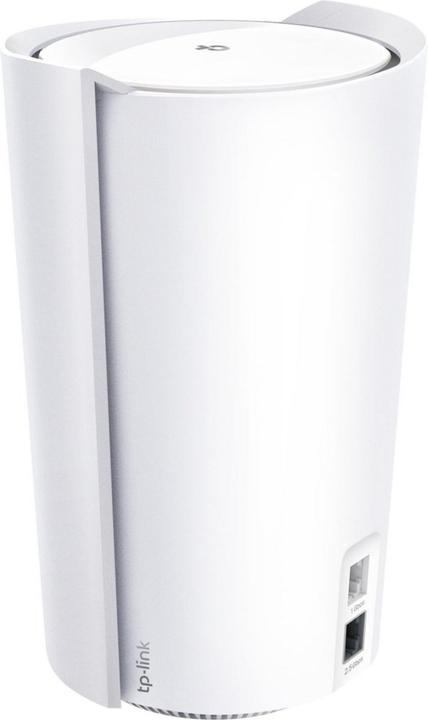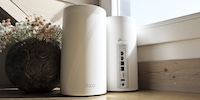

Mesh Wi-Fi Speed Test: the TP-Link Deco X90 truly takes off if you double up
Two Deco-X90 routers from TP-Link leave all mesh systems tested so far behind in my apartment Wi-Fi speed test.
I test routers and mesh systems in my two-story loft, checking the signal level, latency and download speed per room. This time, two Deco X90s from TP-Link are up to bat.
I sourced both review products from our warehouse. We offer the router in a pack of two and individually.
What hardware and features do the two routers offer?
The mesh system offers Wi-Fi 6, with six antennas inside each Deco-X90 router. Four of them are supposed to provide strong Wi-Fi around the device – the other two are responsible for a stable connection between routers. TP-Link relies on tri-band for this. Here, a third frequency band is intended to provide strong connectivity – i.e. strong backhaul – among network devices in the 5 GHz range.
If you prefer to set up your new mesh Wi-Fi with an Ethernet cable as a backhaul, you can do that as well with this system. In my test, however, I relied on the tri-band wireless solution for a better comparison with previous reviews.
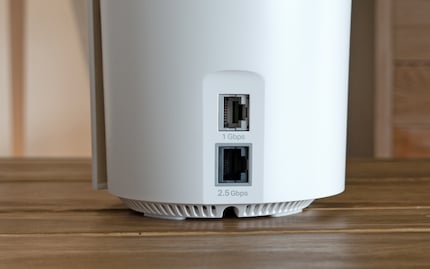
The Deco X90’s connection slots are a bit sparse. It offers only two RJ45 ports. However, one of them still offers a data throughput of up to 2.5 gigabits per second – the second up to one gigabit.
Specifications for the Deco-X90 router:
| Processor | 1,5 GHz Quad-Core CPU |
|---|---|
| Antennas | 6× internally (4× High-Gain, 2× Smart – for backhauling) |
| Ports | 1× RJ45 2,5-Gigabit, 1× RJ45 Gigabit |
| 2,4 GHz standards | IEEE 802.11ax/n/b/g |
| 5 GHz standards | IEEE 802.11ax/ac/n/a |
| 2,4 GHz speeds | up to 574 Mbps |
| 5 GHz speeds | up to 4804 Mbps |
| 5 GHz speeds – third band | up to 1201 Mbps |
| Uses | Router, Access Point |
| Encryption and security | WPA3-Personal, WPA2-Personal, WPA-Personal, SPI Firewall, Access Control and more |
| Features | Mesh-WiFi following the Wi-Fi 6 standard, Tri-Band, Beamforming, 4x4 MU-MIMO, OFDMA, Guest Network, UPnP and more |
| Operation | Reset button |
| Size | 13×12,3×21 cm, 716 g |
Commissioning via the app
Setup is done via the «TP-Link Deco» app, available for Android and iOS. As far as I know, setup via a web interface isn’t possible. The web interface can be accessed via the router’s IP address. However, it only shows data and cannot be used to configure the Wi-Fi or other primary settings.
To set up the two devices, I followed the instructions in the app. I connected my modem to the primary router by cable and started it. Make sure to wait until the LED no longer lights up yellow, but blue. Then the device appeared in my app. The app connected to the router’s temporarily open Wi-Fi – then I was allowed to set up my new network, SSID «Hack-mi-Net» («Don’t-hack-me»).
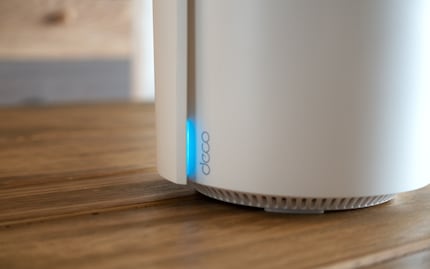
Once the first Wi-Fi 6 unit was operational, the app alerted me that the router would automatically connect to additional mesh nodes within 120 seconds. Convenient, you don’t have to trigger the connection process manually. The second unit was recognised flawlessly. LEDs on both routers are now permanently green. My mesh Wi-Fi was up and running.
You can also turn off the LEDs or automate them to only light up during the day. A corresponding option can be found in the app, where all other fine-tuning settings for the new mesh are also located. For example, I enabled «Fast Roaming» (IEEE 802.11r), which can provide uninterrupted switching between different nodes/satellites – different Wi-Fi networks. I’ve had positive experiences with my endpoints regarding this setting. Video calls remain uninterrupted even when I’m walking around the apartment.
Apartment floor plan and router location
I set up the two Deco X90s in my flat in the same places where corresponding devices were located during my previous mesh Wi-Fi speed tests. I set up the node, which functions as a router, in the upper attic of my 140-m² maisonette near the most central power socket. The extension node was placed on the floor below in the entrance area. This offered the best signal strength for the device on the lower floor from the one above – allowing for the ideal radio backhaul between both nodes. A signal has to make its way through the flat, past floor heating and thick reinforced concrete.


Speed, ping and signal strength per room
Before testing, I gave the new network three days to penetrate all rooms. Then I reached for the same Wi-Fi-6 capable notebook I always use – an Asus ZenBook Duo. I ran the «NetSpot» software to determine signal strength and create heat maps. To determine latency, I also pinged my NAS. I determined download speeds by operating my NAS. All measurements were taken at the same 37 points in my flat, as always. They can be seen in the map below.
Results
The TP-Link Deco X90 Mesh performs as follows:
| Location | 5 GHz frequency band
Speed / ping / signal strength | 2,4 GHz frequency band
Speed / ping / signal strength |
|---|---|---|
| Entrance hall | 454,12 Mbps / 4 ms / −39 dBm | 270,75 Mbps / 4 ms / −42 dBm |
| Living room | 444,27 Mbps / 5 ms / −60 dBm | 232,88 Mbps / 5 ms / −54 dBm |
| Dining room | 434,68 Mbps / 5 ms / −59 dBm | 231,47 Mbps / 6 ms / −59 dBm |
| Kitchen | 440,52 Mbps / 4 ms / −54 dBm | 249,08 Mbps / 5 ms / −47 dBm |
| Balcony | 429,61 Mbps / 8 ms / −72 dBm | 199,49 Mbps / 9 ms / −66 dBm |
| Room 1 | 447,23 Mbps / 5 ms / −61 dBm | 227,62 Mbps / 5 ms / −51 dBm |
| Bathroom | 445,16 Mbps / 5 ms / −61 dBm | 237,56 Mbps / 6 ms / −54 dBm |
| Corridor | 901,60 Mbps / 4 ms / −47 dBm | 293,00 Mbps / 4 ms / −55 dBm |
| Room 2 | 862,12 Mbps / 5 ms / −60 dBm | 253,15 Mbps / 5 ms / −60 dBm |
| Room 3 | 911,55 Mbps / 3 ms / −41 dBm | 317,21 Mbps / 3 ms / −38 dBm |
| Room 4 | 903,15 Mbps / 4 ms / −56 dBm | 282,80 Mbps / 4 ms / −51 dBm |
| Shower/WC | 901,70 Mbps / 4 ms / −55 dBm | 273,64 Mbps / 4 ms / −56 dBm |
| Ø Lower loft floor | 442,23 Mbps / 5 ms / −58 dBm | 235,55 Mbps / 6 ms / −53 dBm |
| Ø Upper loft floor | 896,02 Mbps / 4 ms / −52 dBm | 283,96 Mbps / 4 ms / −52 dBm |
| Ø Flat | 631,31 Mbps / 5 ms / −55 dBm | 255,72 Mbps / 5 ms / −53 dBm |
My Wi-Fi reaches lightning speeds on the upper floor. It penetrates walls like a hot knife through butter, reaching around 900 Mbps in all rooms within the 5 GHz frequency band. I have never had a router perform so strongly on a single floor. The strongest device to date was a Linksys Velop AX4200 averaging 782.61 Mbps on the upper floor. The same goes for the 2.4 GHz frequency band, where TP-Link achieves an average of 283.96 Mbps. Until now, the highest speed reached in this frequency was 184.03 Mbps – also with the Linksys router.
In the lower attic, I still achieved a decent 442.23 Mbps at 5 GHz with TP-Link. The speed was halved, but it’s still incredibly high – 44 per cent of my Internet connection speed. However, this isn’t the best I’ve seen. Netgear was a lot faster with its Orbi AX6000, achieving an average of 601.18 Mbps. For 2.4 GHz, the Asus ZenWiFi AX has been leading the charge at 146.42 Mbps on the lower floor. TP-Link smashes that by 235.55 Mbps.
Across my entire home, TP-Link’s mesh is the new Wi-Fi speed test king with 631.31 Mbps and 255.72 Mbps, respectively – as seen when compared with competitors below. But before that, a quick look at latency – ping – and especially signal strength.
The response time that a signal needs to find its way from a laptop to the NAS and back – ping – averages five milliseconds in both frequency bands. A good value, which fits perfectly for my non-professional online gaming skills. Incidentally, no mesh system or single router has ever managed less than three milliseconds in my flat – that’s only possible via a cable connection.
Visualising the 5 GHz Wi-Fi coverage
Signal strength averaged -55 decibel milliwatts (dBm) in the 5 GHz frequency band across my entire home. A strong value and the second strongest I’ve ever measured. A Swisscom mesh consisting of the Internet Box 3 and WLAN Box 2 also reached -55 dBm – only the Velop AX4200 from Linksys at -54 dBm was slightly better.
The only place where certain terminals may change band/network due to a too weak signal is the balcony. Here, -72 dBm prevail. By certain devices, I mean smartphones such as the iPhone. It’s only supposed to prefer the 5 GHz frequency band up to -65 dBm and then switch to 2.4 GHz. From there, it should switch to mobile Internet at -70 dBm. In any case, I’m happy that my devices are still chugging along even at -75 dBm. And they don’t incur a big speed penalty compared to other rooms on the same floor. This hasn’t been the rule so far.
The following heat maps visualise the decent signal coverage. Signal strength is represented by specific colours. I set the colour scale from -35 to -80 dBm. Above -80 dBm, most devices can no longer communicate with the router. High dBm values are therefore better than low ones. The more colour goes from red, yellow and green towards blue, the worse a value is.


Visualising the 2.4 GHz Wi-Fi coverage
In the 2.4 GHz frequency band, -53 dBm is possible in an average apartment. The heat map remains a turquoise green even on the balcony, and thus typically has a slightly better performance in range compared to 5 GHz.

Comparing with the competition
Compared to the mesh systems tested so far, TP-Link is in pole position. The crown previously belonged to the Deco X90. Nevertheless, my ranking shows that it was an extremely close race across both floors, at least in the 5 GHz frequency range. Netgear is virtually on par with Orbi, only 1.67 Mbps weaker.
The 5 GHz comparison:
| Mesh Wi-Fi system | Ø 5-GHz frequency band across flat
Speed / ping / signal strength |
|---|---|
| TP-Link Mesh: Deco X90
(Wi-Fi 6, 2 access points) | 631,31 Mbps / 5 ms / −55 dBm |
| Netgear Mesh: Orbi AX6000
(Wi-Fi 6, 2 access points) | 629,64 Mbps / 5 ms / −58 dBm |
| Linksys Mesh: Velop AX4200
(Wi-Fi 6, 2 access points) | 525,23 Mbps / 7 ms / −54 dBm |
| Swisscom Mesh Wi-Fi 6
(Internet-Box 3 + WLAN-Box 2) | 482,14 Mbps / 3 ms / −55 dBm |
| Asus Mesh: ZenWiFi AX6600
(Wi-Fi 6, 2 access points) | 467,36 Mbps / 3 ms / −57 dBm |
| Devolo Mesh: Magic 2 WiFi 6
(3 access points) | 220,15 Mbps / 6 ms / −62 dBm |
| Devolo Mesh: Mesh WiFi 2
(Wi-Fi 5, 3 access points) | 214,44 Mbps / 6 ms / −60 dBm |
The 2.4 GHz comparison:
| Mesh Wi-Fi system | Ø 2,4-GHz frequency band across flat
Speed / ping / signal strength |
|---|---|
| TP-Link Mesh: Deco X90
(Wi-Fi 6, 2 access points) | 255,72 Mbps / 5 ms / −53 dBm |
| Linksys Mesh: Velop AX4200
(Wi-Fi 6, 2 access points) | 150,82 Mbps / 7 ms / −59 dBm |
| Asus Mesh: ZenWiFi AX6600
(Wi-Fi 6, 2 access points) | 139,77 Mbps / 3 ms / −56 dBm |
| Netgear Mesh: Orbi AX6000
(Wi-Fi 6, 2 access points) | 128,53 Mbps / 5 ms / −54 dBm |
| Devolo Mesh: Magic 2 WiFi 6
(3 access points) | 128,09 Mbps / 7 ms / −59 dBm |
| Devolo Mesh: Mesh WiFi 2
(Wi-Fi 5, 3 access points) | 126,70 Mbps / 7 ms / −57 dBm |
| Swisscom Mesh Wi-Fi 6
(Internet-Box 3 + WLAN-Box 2) | 117,26 Mbps / 4 ms / −59 dBm |
Verdict: a strong mesh system with lightning speed
The TP-Link Deco X90 mesh impressed me a lot. 896.02 Mbps at 5 GHz on the upper floor is a feat that no other system will so easily top. At 442.23 Mbps, about half the speed still arrives on the lower floor. This isn’t the best performance I’ve seen, but still a very good value.
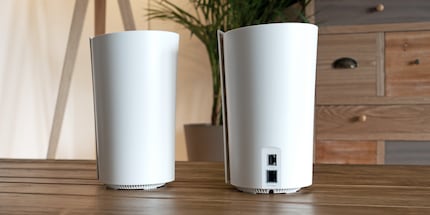
In the competitive comparison across my entire home, TP-Link is on par with the Netgear Orbi AX6000 with 631.31 Mbps at 5 GHz, which in turn comes in at 629.64 Mbps. In the 2.4 GHz range, TP-Link’s 255.72 Mbps keeps the previous best system, a Linksys Velop AX4200 Mesh, at bay by a whole 100 Mbps.
In terms of price, the Deco X90 is in the mid-range compared to other mesh systems. Which is why I can wholeheartedly recommend its great performance. The only thing that bothers me about it is that the routers only have two network ports each. Still, at least one of them is designed for a speed of up to 2.5 Gbps.
I find my muse in everything. When I don’t, I draw inspiration from daydreaming. After all, if you dream, you don’t sleep through life.
